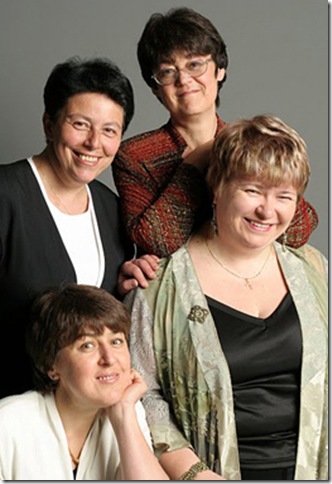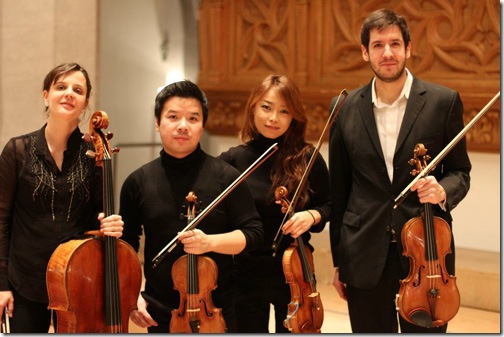Editor’s note: Here are two late reviews of recent concerts at the Flagler Museum:
The Moscow String Quartet (Feb. 21)
Sitting in the magnificence of Henry Flagler’s Gilded Age mansion, Whitehall, I was struck by the ironic contrast of listening to a string quartet that began life in the old USSR.
This was the Moscow String Quartet, four women whose exceptionally high standards proved what I’d always known: Teaching methods in an oppressive Russia let loose the passion of the inner soul, however dignified the performer. Surviving, and bridging the gap from communism to a market economy, complete with oligarchs, speaks volumes for Eugenia Alikhanova, first violin; Galina Kokhanovskaia, second violin; Tatiana Kokhanovskaia, viola, and Olga Ogranovich, cello.
Opening with Beethoven’s String Quartet No. 4 (in C minor, Op. 18, No. 4), it was evident we were in for a night of full-bodied, beautifully rounded sounds. The first movement, Allegro ma non tanto, showed the exceptional skill of the Alikhanova as she soared above her colleagues. In the second movement, a delicate fugue begins on the second violin and is passed around. Beethoven works this little tune relentlessly and the strings begin to sing: What incredible musicianship.
Tuning up for the third movement was reassuring as the four launched into some “nice” playing, darker in color now , recapitulating and reworking tunes from the first movement. A cheeky melody on the cello starts the first Allegro, which is passed up to the viola, then the second and first violins. In the race to the end, there was a little off-key insensitivity, but this didn’t mar a brilliant performance.
Shostakovich’s First String Quartet (in C, Op. 49) followed. This is one of the works that “rehabilitated” the composer in 1938 after he fell out of official favor in a Pravda attack on his popular opera, Lady Macbeth of the Mtsensk District.
In form, this quartet is simplicity indeed. As the top three instruments play long sustained single notes, they are broadly underpinned by the cello’s excellently played glissandi. The first violin continues with what I felt to be bird-like songs; a thrush or nightingale, maybe.
The second movement is led in by the violist. It was here I began to realize that Shostakovich, in keeping it simple, had taken the essentials of the 12-tone method of composition and distilled it down into an accessible formula, easier on the ear. Now the music begins to sound very Russian, with that opening melody from the viola again. Plucked strings over the cello — haunting, compelling sounds — end the movement suddenly.
Movement three starts with muted strings that accompany a lively solo by Alikhanova. Lively music at times descends into darker hues: Stalin wagging a finger of disapproval at the composer, is what came to mind. High-energy playing describes the last movement, with hints of the scherzo from Shostakovich’s Fifth Symphony, also a work of rehabilitation. A volume of symphonic grandeur poured forth from these four fine musicians to end this joyful and lyrical quartet, a good example of Shostakovich’s genius.
Borodin’s Second String Quartet ended the program. Dedicated to his wife, written in 1882, it was a sweet and crowd-pleasing choice. In the Allegro of the first movement hints of the kind of music that the creators of Kismet in 1953 would find hard to resist, began to appear. The second movement (cribbed for Baubles, Bangles and Beads) was played with great feeling by the quartet. The third movement (lifted for And This Is My Beloved) is a nocturne for cello, played lovingly here by Ogranovich.
The last movement is a masterpiece of brilliantly constructed music, with questions and answers going back and forth and melodies galore of a short exquisite nature. The Moscow String Quartet must have played this work a thousand times, but they came at it freshly and played beautifully. – Rex Hearn
Stradivari Quartet (Feb. 7)
It’s been a long time since one of the six quartets of Bela Bartok has made its way to a local concert, and when one finally arrived at the Flagler Museum, it proved to be a shattering experience.
The Swiss-based Stradivari Quartet, which among other things is distinguished by the fact that all four of its members play Stradivarius instruments, brought the Fourth Quartet (in C, Sz. 91) of Bartok, written in 1928, to its program, which also included music by Schubert and Brahms, in the chamber music series at Whitehall.
This is about as uncompromising a work as there is in the standard repertory, an extraordinary blend of deep folk sources, aggressive performance techniques and astringent harmonies. But unlike a lot of works that listeners consider atonal, this quartet has a logical and exotic sound world in which each color of its tonal palette is carefully chosen.
The Stradivari – violinists Xiaoming Wang and Soyoung Yoon, violist Lech Uszynski and cellist Maja Weber – proved to be an exemplary quartet, as indeed you’d have to be to play music of this kind of perilous difficulty. The first movement, in many ways the hardest one to parse, had unabashed intensity and ideal ensemble, crucial in a work like this. The Stradivari made a point, too, of emphasizing the little six-note motif that recurs throughout (and appears at the end of the piece) with almost brutal force.
The same intensity traveled into the second movement, a murmuring, restless piece in which all four of the instruments are muted. This had terrific drive, and the quartet gave the music’s sudden shocks real presence. Cellist Weber was the standout in the “night music” of the third movement, with a gorgeous sound for her extended solo that soared beautifully over the sustained chords of her colleagues.
In the fourth, the Stradivari’s tight ensemble made the all-pizzicato texture quirky and absorbing; second violinist Yoon and violist Uszynski were particularly forceful here. In the fifth and final movement, the foursome brought everything back to tempestuousness with the ferocious opening chords, and in the various unison moments, the four played impeccably as one, which added substantial power to the music.
The concert opened with an early quartet by Schubert, his No. 9 in G minor (D. 173), written when he was 18. I do not and have never understood the critical reluctance to accept these early quartets as the accomplished works they are, never mind their obvious derivations from the earlier Viennese masters.
This performance had strength and delicacy in equal measure; the second movement was exquisitely played, with great elegance for the main theme and careful attention to dynamics. The third, a close cousin to the minuet from Mozart’s Symphony No. 40, was urgent, but not overwhelmingly so, and the rapid buzzing figures in the finale were transferred ably from Wang to his colleagues.
The second half of the concert was devoted to the Second Quartet (in A minor, Op. 51, No. 2) of Brahms. This is Brahms at his richest, with a wealth of melodic inspiration and a mood of deep seriousness throughout.
The Stradivari brought softness and tenderness to the first movement, particularly the thematic material based on the back-and-forth half-step, and here again, dynamics were critical, with the four players adding striking effects such a beautifully judged diminuendo.
The Andante moderato had a touch of rubato in the opening measures, which was effective, and the contrasting minor-key motif was quite loud and full, making an excellent contrast. The opening triplet gesture in the third-movement minuet was light and playful, rather than somber, and that approach was maintained throughout, so that the rapid chattering passages in the major-key section that came afterward had an almost Mendelssohnian feel.
In the finale, the Stradivari also was guided by the varied moods of the work, playing extremely softly in the repeated one-two chords before the fugal section, and taking the contrasting section with the cello melody slightly slower, which made it richer.
For an encore, the group played what I think was a string quartet arrangement of the Chinese Galop of Johann Strauss II; it was charming and robustly played. – Greg Stepanich

